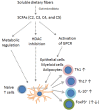Gut microbiota-derived short-chain Fatty acids, T cells, and inflammation
- PMID: 25550694
- PMCID: PMC4275385
- DOI: 10.4110/in.2014.14.6.277
Gut microbiota-derived short-chain Fatty acids, T cells, and inflammation
Abstract
T cells are central players in the regulation of adaptive immunity and immune tolerance. In the periphery, T cell differentiation for maturation and effector function is regulated by a number of factors. Various factors such as antigens, co-stimulation signals, and cytokines regulate T cell differentiation into functionally specialized effector and regulatory T cells. Other factors such as nutrients, micronutrients, nuclear hormones and microbial products provide important environmental cues for T cell differentiation. A mounting body of evidence indicates that the microbial metabolites short-chain fatty acids (SCFAs) have profound effects on T cells and directly and indirectly regulate their differentiation. We review the current status of our understanding of SCFA functions in regulation of peripheral T cell activity and discuss their impact on tissue inflammation.
Keywords: Colitis; FoxP3; IL-10; Inflammation; Microbial metabolites; Microbiota; Short-chain fatty acids; Th1; Th17.
Conflict of interest statement
The authors have no financial conflict of interest.
Figures


References
-
- Heinonen KM, Perreault C. Development and functional properties of thymic and extrathymic T lymphocytes. Crit Rev Immunol. 2008;28:441–466. - PubMed
-
- Bhandoola A, von BH, Petrie HT, Zuniga-Pflucker JC. Commitment and developmental potential of extrathymic and intrathymic T cell precursors: plenty to choose from. Immunity. 2007;26:678–689. - PubMed
Publication types
Grants and funding
LinkOut - more resources
Full Text Sources
Other Literature Sources
Medical

